Description
ALMA disk surveys have shown that a large fraction of observed protoplanetary disks in nearby SFRs are fainter than expected in CO isotopologue emission. Disks not detected in 13CO line emission are also faint and often unresolved in the continuum emission at an angular resolution of around 0.2 arcseconds. Does this population comprise radially extended and low mass disks - as commonly assumed so far - or is it of intrinsically radially compact disks? A new grid of DALI physical-chemical models of compact disks has been compared with 12CO and 13CO ALMA observations of faint disks in the Lupus SFR. Lupus disks that are not detected in 13CO emission and with faint or undetected 12CO emission are consistent with compact disk models. For disks with a limited radial extent, the emission of CO isotopologues is mostly optically thick and it scales with the surface area: i.e., it is fainter for smaller objects. The fraction of compact disks is potentially between roughly 50% and 60% of the entire Lupus sample. If the fainter end of the disk population observed by ALMA disk surveys is consistent with such objects being very compact, will either create a tension with viscous spreading or require MHD winds or external processes to truncate the disks. An interesting implication to planet formation is that, in such small and optically thick disks, there may be substantial reservoirs of gas for forming Jupiter-like planets within Jupiter’s orbital radius.

